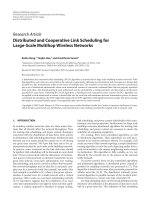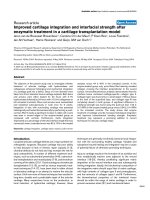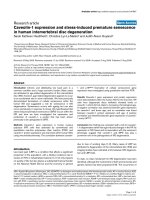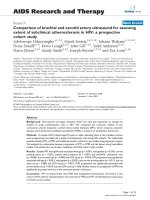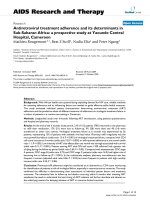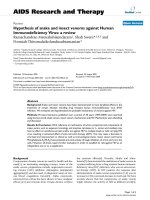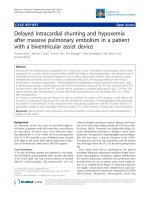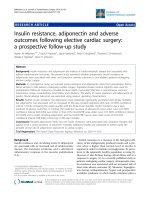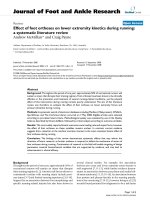Báo cáo y học: " Manual therapy with and without vestibular rehabilitation for cervicogenic dizziness: a systematic review" doc
Bạn đang xem bản rút gọn của tài liệu. Xem và tải ngay bản đầy đủ của tài liệu tại đây (344.16 KB, 11 trang )
REVIE W Open Access
Manual therapy with and without vestibular
rehabilitation for cervicogenic dizziness: a
systematic review
Reidar P Lystad
*
, Gregory Bell, Martin Bonnevie-Svendsen and Catherine V Carter
Abstract
Background: Manual therapy is an intervention commonly advocated in the management of dizziness of a
suspected cervical origin. Vestibular rehabilitation exercises have been shown to be effective in the treatment of
unilateral peripheral vestibular disorders, and have also been suggested in the literature as an adjunct in the
treatment of cervicogenic dizziness. The purpose of this systematic review is to evaluate the evidence for manual
therapy, in conjunction with or without vestibular rehabilitation, in the management of cervicogenic dizziness.
Methods: A comprehensive search was conducted in the databases Scopus, Mantis, CINHAL and the Cochrane
Library for terms related to manual therapy, vestibular rehabilitation and cervicogenic dizziness. Included studies
were assessed using the Maa stricht-Amsterdam criteria.
Results: A total of fifteen articles reporting findings from thirteen unique investigations, including five randomised
controlled trials and eight prospective, non-controlled cohort studies were included in this review. The
methodological quality of the included studies was generally poor to moderate. All but one study reported
improvement in dizziness following either unimodal or multimodal manual therapy interventions. Some studies
reported improvements in postural stability, joint positioning, range of motion, muscle tenderness, neck pain and
vertebrobasilar artery blood flow velocity.
Discussion: Although it has been argued that manual therapy combined with vestibular rehabilitation may be
superior in the treatment of cervicogenic dizziness, there are currently no obse rvational and experimental studies
demonstrating such effects. A rationale for combining manual therapy and vestibular rehabilitation in the
management of cervicogenic dizziness is presented.
Conclusion: There is moderate evidence to support the use of manual therapy, in particular spinal mobilisation
and manipulation, for cervicogenic dizziness. The evidence for combining manual therapy and vestibular
rehabilitation in the management of cervicogenic dizziness is lacking. Further research to elucidate potential
synergistic effects of manual therapy and vestibular rehabilitation is strongly recommended.
Keywords: Cervicogenic dizziness, Vertigo, Manual therapy, Vestibular rehabilitation, Spinal manipulation,
mobilisation
Background
Dizziness is a non-specific symptom that is commonly
encountered by primary health care practitioners [1],
and the prevalence has been reported to be between
11.1% and 28.9% [2-5]. It can be experienced as faint-
ness, unsteadiness, perception of spinning and
disorientation [6-8]. The mechanisms producing these
symptoms are multiple and can i nvolve several different
organ systems. Ardc, Topuz and Kara [9] reported the
most frequent diagnosis of patients suffering from dizzi-
ness to be benign paroxysmal positional vertigo, endo -
lymphatic hydrops, migraine, central decompensation,
acute vestibulopathy and autonomic dysfunction.
Furthermore, it is not uncommon for patients experien-
cing dizziness to have more than one diagnosis.
* Correspondence:
Department of Chiropractic, Macquarie University, Sydney, Australia
Lystad et al. Chiropractic & Manual Therapies 2011, 19:21
/>CHIROPRACTIC & MANUAL THERAPIES
© 2011 Lystad et al ; licensee BioMed Central Ltd. This is an Open Access article distributed under the terms of the Creative Commons
Attribution License ( ), which permits unrestricted use, distribution, and reproduction in
any medium, provided the original work is properly cited.
Dizzin ess is commonly seen in whiplash patients, affect-
ing 20-58% of individuals with flexion-extension injuries
[10].
One specific type of dizziness is cervicogenic dizziness.
The disorder was first described as “cervical vertigo” by
Ryan and C ope in 1955 [11]. Other terms used for the
same disorder are proprioceptive vertigo, cervicogenic
vertigo and cervical dizziness [12-14]. Although the
diagnosis has remained controversial sin ce its introduc-
tion, several observations have led to the proposal of a
plausible pathophysiological mechanism. The deep inter-
vertebral muscles in the cervical spine possess a high
density of muscle spindles and are assumed to play an
important role in postural control [15-18]. Ce rvical
afferents are known to be involved in the cervico-collic
reflex, the cervico-ocular reflex and the tonic neck
reflex, which work in conjunction with other reflexes
influenced by visual and vestibular s ystems to stabilise
the head, the eyes and posture [19]. Vestibular and pro-
prioceptive input is linearly combined for computing
egocentric, body-centred coordinates [20].
Several authors have demonstrated that anaesthetic
injections to the upper cervical dorsal nerve roots can
produce dizziness and nystagmus [21-23]. Electrical st i-
mulation to cervical muscles has also been shown to
induce a sensation of tilting or falling [24]. Brandt and
Bronstein [25] proposed a mechanism where changed
firing characteristics of cervic al somatosensory recep tors
due to neck pain lead to a sensory mismatch between
vestibular and cervical input, resulting in cervical
vertigo.
Several authors have proposed manual therapy inter-
ventions for the tr eatment of dizziness of a cervical ori-
gin [26-28]. Indeed, it has been suggested that the
management of cervicogenic dizziness should be the
same as for cervical pain [25]. In a systematic review of
the literature, Reid and Riv ett [29] concluded that there
is limited evidence to support manual therapy treatment
of cervicogenic dizziness. Moreover, it was recom-
mended that further research be conducted, especially
randomised controlled trials (RCTs), to provide more
conclusive evidence of the role of manual therapy for
cervicogenic dizziness.
Another treatment modality that is advocated for cer-
vical pain is sensorimotor rehabilitation exercises
[19,30]. These exercises fall under the scope of exercises
included in vestibular rehabilitation therapy. Vestibular
rehabilitation emerged as a group of exercises for per-
ipheral vestibular disorders, aiming to maximise central
nervous system compensation to vestibular pathology
[31,32]. These exercises are usually movement based,
and can be further subcategorised according to different
physiological rationales: (i) compensatory responses
using motion to habituate activity in t he vestibular
nuclei; (ii) adaptation for visual-vestibular interaction
and possibly eye/hand coordination, using repetitive and
provocative movements of the head and/or eyes; (iii)
substitution which promotes the use of individual or
combinations of sensory inputs to bias use away from
dysfunctional vestibular input; (iv) postural control exer-
cises, falls prevention, relaxation training, reconditioning
activities and functional/occupational retraining, which
are based on motor learning principles [33,34].
Hillier and Hollohan [34] concluded that there was
moderate to strong evidence that vestibular rehabilita-
tion is safe and effective in the management of unilateral
peripheral vestibular disorders. Moreover, several
authors encourage the implementation of vestib ular
rehabilitation in treatment of dizziness of a cervical ori-
gin [10,32,35], and publ ished case studies have reported
positive outcomes when combining manual therapy and
vestibular rehabilitation [36,37].
To the authors’ knowledge, the evidence of imple-
menting vestibular rehabilitation with manual therapy in
the management of cervicogenic dizziness has not been
systematically reviewed. Thus, the purpose of this sys-
tematic review was: (i) to provide an updated systematic
review of manual therapy for cervicogenic dizziness by
including higher level evidence published since the pre-
vious review by Reid and Rivett [29], and (ii) to compare
the evidence of (a) manual therapy with vestibular reha-
bilitation for cervicogenic dizziness with (b) manual
therapy without vestibular rehabilitation for cervicogenic
dizziness.
Methods
This systematic review adhered to the guidelines out-
lined in the Preferred Reporting Items for Systematic
Reviews and Meta-Analyses (PRISMA) Statement [38].
Eligibility criteria
This systematic review was limited to prospective, con-
trolled or non-controlled intervention studies published
in peer-reviewed journals. Retrospective s tudy designs,
case reports, case series, commentaries, letters to the
editor, and expert opinions were excluded from this
review. No language restrictions were applied in this
review.
Eligible studies had to investigate a cohort of patients
diagnosed with cervicogeni c dizziness. Cervicogenic diz-
ziness was defined as the presence of dizziness, imbal-
ance or unsteadiness related to movements or position
of the cervical spine, or occurring with a stiff or painful
neck [29]. Studies investigating populations diagnosed
with cardiovascular disorders, central nervous system
disorder (e.g. cerebellar ataxia, stroke, demyelination),
Mal de Debarquement syndrome, migraine-associated
vertigo, psychogenic dizziness, vestibular disorders (e.g.
Lystad et al. Chiropractic & Manual Therapies 2011, 19:21
/>Page 2 of 11
benign paroxysmal positional vertigo, Meniere’s disease,
peripheral vestibulopathy), were not included in this
review. Studies were also excluded if the study popula-
tion was comprised of patients with a history of active
inflammatory joint disease, spinal cord pathology, cervi-
cal spine cancer or infection, bony disease or marked
osteoporosis, marked cervical spine disc protrusion,
acute cervical nerve root symptoms, fracture or disloca-
tion of the neck, or previous surgery to the upper cervi-
cal spine.
This review considered two possible interventions,
namely manual therapy alone and manual therapy in
conjunction with vestibular rehabilitation. For the pur-
poses of this review, manual ther apy was defined as
spinal manipulation (high velocity, low amplitude tech-
niques) or mobilisation (low-velocity, small or large
amplitude techniques) [29]. Vestibular rehabilitation was
defined as an exercise-based group of approaches with
the aim of maximising the central nervous system com-
pensation for vestibular pathology [39]. Vestibular reha-
bilitation techniques included habituation (movement
provoking) with gaze stabilising (adaptation), sensory
substitution, and balance and gait/activity training [34].
Search Strategy
A comprehensive search of the literature was conducted,
including electronic searches of the Scopus, Mantis, and
CINAHL databases from January 1955 to June 2010. In
addition, the Cochrane Library was searched from
inception (1993) to June 2010 to identify any relevant
Cochrane Reviews. Keywords used in the lit erature
search included “cervicogenic dizziness” and “manual
therapy” . Alternative spellings, synonyms and related
terms, and truncated versions of both the condition and
the intervention were included. In addition, bibliogra-
phies of included studies and relevant review articles
were hand searched to indentify potentially eligible stu-
dies not captured by the electronic searches.
Study selection
Citations from the electronic searches were combined in
a single list and duplicate records were discarded. Two
reviewers screened all titles and abstracts to identify and
remove obviously irrelevant citations. Full text versions
of all potentially eligible articles were retrieved and eval-
uated by two independent reviewers to determine elig-
ibility for inclusion in this review. Any differences were
resolved by mutual consensus with a third independent
reviewer.
Data extraction process
Data from eligible studies were extracted and compiled
in a spreadsheet. For the purposes of this systematic
review the following data were extracted: (i) study
population (e.g. age, gender, diagnosis, and sample size);
(ii) study design; (iii) intervention; (iv) outcome mea-
sures; and (v) main findings.
Data analysis
Owing to the clinically heterogeneous nature of the
included studies (i.e. varying study designs, interven-
tions, outcome measures, and quality of data), a meta-
analysis was deemed unfeasible. Thus, in this review
only a qualitative analysis of included studies was under-
taken. As per the previous review by Reid and Rivett
[29], qualitative analysis was achieved by attributing
levels that rate the scientific evidence, i.e. Level 1:
Strong evidence (provided by generally consistent find-
ings in multiple higher quality RCTs); Level 2: Moderate
evidence (provided by generally consistent findings in
one higher quality RCT and one or more lower quality
RCTs); Level 3: Limited evidence (provided by generally
consistent findings in one or more lower quality RCTs);
and Level 4: No evidence (if there were no RCTs or if
the results were conflicting).
Assessment of methodological quality
The methodological quality of the included studies was
assessed using the Maastricht-Amsterdam criteria [40].
The Maastricht-Amsterdam criteria list, which consists
of 19 items assessing patient selection, interventions,
outcome measures and statistics, is included in Addi-
tional file 1. Two independent reviewers assessed meth-
odological quality and any differences were resolved by
mutual consensus with a third independent reviewer.
Each item was answered “ yes” , “ no” ,or“don’ tknow”,
and one poin t was assigned for each “yes” (fulfilled
item). The assessed studies were categorised as either
poor, moderate or good based on the percentage of ful-
filled items from the Maastricht-Amste rdam criteria list.
In accordance with other authors using similar quality
ass essment methods, the cut-off percentage values we re
arbitrarily set at < 50% (poor), 50-80% (mo derate), and
> 80% (good) [41-43].
Results
The electronic searches returned 658 hits, which
included 335 duplicate records and 323 unique citations.
After removing duplicate records and screening t itles
and abstracts to discard obviously irrelevant citations, a
total of 42 potentially eligible studies were identified. A
hand search revealed four additional studies that were
not captured b y the electronic search. Thus, a total of
46 potentially eligible studies were evaluated for inclu-
sion in this systematic review. Thirty-one studies
[29,36,44-72] did not meet the inclusion criteria and
were excluded from this review. See Additional file 2 for
a list of e xcluded studies incl uding reasons for
Lystad et al. Chiropractic & Manual Therapies 2011, 19:21
/>Page 3 of 11
exclusion. Figure 1 contains a flow diagram of the study
selection process. Two articles [26,73] reported data
fromthesameRCT,andtheresultsfromonecohort
study were published in two separate articles [74,75]
Thus, this review included reports from a total of thir-
teen unique investigations. See Table 1 for a description
of included studies.
The included studies comprised five RCTs [26,76-79]
and eight prospective, non-controlled, cohort studies
[75,80-86], with samples sizes ranging from 12 to 168.
One study [81] did not report on the gender distribution
of recruited participants, however all but one of the
remaining studies included more females, ranging from
52% to 88%.
Six studies [75-77,80-82], including two RCTs [76,77],
used only spinal manipulation or mobilisation, or both,
as the intervention. The remaining seven investigations
[26,78,79,83-86], including three RCTs [26,78,79] uti-
lised a multimodal approach consisting of several differ-
ent interventions (e.g. spinal manipulation and
mobilisation, soft tissue therapy, electrotherapy, and
medications) and home exercise programs. However,
none of the included studies used manual therapy in
conjunction with vestibular rehabilitation.
Figure 1 PRISMA flow diagram.
Lystad et al. Chiropractic & Manual Therapies 2011, 19:21
/>Page 4 of 11
Table 1 Included studies
Study Participants Interventions Outcome measures Main findings Quality
Manual
therapy
Vestibular
rehabilitation
Randomised controlled trials:
Karlberg et
al. 1996
[26];
Malmström
et al. 2007
[44]
n = 34 (88%
females)
Mean age: 37
Age range:
25-55
Country:
Sweden
Setting:
primary care
centers and a
tertiary
referral
center
Mobilisation;
Soft tissue therapy
(relaxation techniques,
stabilisation techniques);
Home training program;
Ergonomic changes at work
Nil Dizziness frequency;
Dizziness intensity;
Posturography
- Significantly improved dizziness
intensity and neck pain post-
treatment (p < 0.05).
- Significantly improved postural
sway post-treatment (p < 0.2).
- 14 patients (82%) reported
improvements at 6 months post-
treatment.
†
- 11 patients (65%) reported
improvements in dizziness at 2
year post-treatment.
†
Moderate
Reid et al.
2008 [47]
n = 34 (62%
females), 1
drop-out
Mean age:
63.5
Age range:
not reported
Country:
Australia
Setting:
University of
Newcastle
Mobilisation (SNAGs) Nil DHI;
Dizziness severity (VAS);
Dizziness frequency;
Neck pain (VAS);
Posturography
- Significantly reduced DHI,
dizziness severity, dizziness
frequency and neck pain in the
treatment group at 6 and 12
weeks post-treatment (p < 0.05).
- No difference in dizziness
severity at 12 weeks post-
treatment.
- No difference in dizziness
frequency at either 6 or 12 weeks
post-treatment.
Good
Kang, Wang
and Ye
2008 [48]
n = 76 (49%
females)
Mean age:
32.4
Age range:
18-45
Country:
China
Setting:
hospital
Group A:
Spinal manipulation
Group B:
Acupressure
Nil TCD-US;
TCM syndrome
diagnostic criteria
- Significantly reduced VBA blood
flow velocity post-treatment in
both groups (p < 0.01).
- Significantly larger reduction in
left and right vertebral artery
blood flow velocity in Group B
compared with Group A (p <
0.01).
- Group differences remained
statistically significant at a 6-
month follow-up.
Moderate
Fang 2010
[49]
n = 168 (73%
females)
Mean age:
37.5
Age range:
not reported
Country:
China
Setting:
hospital
Treatment group:
Spinal manipulation;
Soft tissue therapy
Control group:
TCM medication
Nil CVSFAS;
Colour Doppler
ultrasonography
- Significant improvements in
dizziness (p < 0.01), shoulder/neck
pain (p < 0.05), and headache (p
< 0.01) post-treatment.
- Significant reduction of cervical
artery spasm index and
atlantoaxial displacement index in
the treatment group post-
treatment (p < 0.05).
Moderate
Du et al.
2010 [50]
n = 70 (54%
females)
Mean age:
37.6
Age range:
21-45
Country:
China
Setting:
hospital
Treatment group:
Spinal manipulation;
Soft tissue therapy
Control group:
Traction;
Medication
Nil CVSFAS;
Radiography;
TCD-US;
TCM syndrome
diagnostic criteria
- Significant improvements in
dizziness scores, vertebral
displacement post-treatment (p <
0.01).
- Significantly reduced left and
right vertebral artery blood flow
velocity post-treatment (p < 0.01).
- Significantly improved clinical
outcomes six months post-
treatment (p < 0.01).
Moderate
Prospective cohort studies:
Lystad et al. Chiropractic & Manual Therapies 2011, 19:21
/>Page 5 of 11
Table 1 Included studies (Continued)
Konrad and
Gerencser
1990 [51]
n = 54 (74%
females)
Mean age:
34.7
Age range:
not reported
Country:
Hungary
Setting:
hospital
Mobilisation;
Manipulation
Nil Dizziness (instrument
not specifically stated);
Electronystagmography
- 40 patients (74%) experienced
improvement of dizziness post-
treatment.
†
Poor
Mahlstedt,
Westhofen
and König
1992 [52]
n=28
(gender
distribution
not reported)
Mean age:
not reported
Age range
not reported
Country:
Germany
Setting: not
reported
Spinal manipulation Nil No information provided - 19 patients (68%) reported
reduced dizziness post-treatment.
†
Poor
Uhlemann
et al. 1993
[53]
n = 12*
(gender
distribution
not reported)
Mean age:
40.7
Age range:
not reported
Country:
Germany
Setting: not
reported
Mobilisation;
Spinal manipulation
(traction)
Nil Cervical turn test - 5 out of 9 patients went from
testing positive to testing negative
on the cervical turn test post-
treatment.
Poor
Bracher et
al. 2000 [54]
n = 15 (80%
females), 3
drop-outs
Mean age: 41
Age range:
27-82
Country:
Brazil
Setting:
chiropractic
clinic
Spinal manipulation;
Soft tissue therapy;
Electrotherapy;
Labyrinth sedation
medication;
sEMG biofeedback;
Exercise program
Nil Dizziness (instrument
not specifically stated;
“improvement of
symptoms was based on
patient’s reports”)
- 9 patients (60%) reported
complete remission of dizziness, 3
patients (20%) reported consistent
improvement with rare recurrence
of episodes of mild intensity, and
3 patients (20%) reported no
change.
†
Poor
Hülse and
Hölzl 2000
[55]
n = 67 (52%
females)
Mean age: 49
Age range:
18-66
Country:
Germany
Setting: not
reported
Soft tissue therapy (traction
massage, PIR,
occipital-base-release
technique, atlas-impulse-
therapy)
Nil Craniocorpography;
Posturography
- Significant improvements in
pathological vestibulospinal
reactions found post-treatment (p
< 0.001).
Poor
Chen and
Zhan 2003
[56]
n = 16 (38%
females)
Mean age:
42.4
Age range:
38-58
Country:
China
Setting:
hospital
Spinal manipulation;
Soft tissue therapy
Nil TCD-US;
Radiography;
TCM syndrome
diagnostic criteria
- 14 patients (87.5%) reported
marked improvement or complete
remission of symptoms.
- Significantly decreased vertebral
artery mean blood flow velocity
post-treatment (p < 0.05).
- Significantly reduced vertebral
displacement post-treatment (p <
0.05).
Poor
Lystad et al. Chiropractic & Manual Therapies 2011, 19:21
/>Page 6 of 11
Twelve studies, incl uding a ll five RCTs, reported
improvements in dizziness and associated symptoms (e.
g. neck pain) following manual therapy intervention.
The remaining study measured skull spatial offset repo-
sitioning ability, and found a significant improvement
following soft tissue manipulation [75]. In addition to
reduction in dizziness and associated symptoms, two
RCTs [77,79] reported significant changes in vertebroba-
silar artery blood flow velocity post-treatment, and a
further two RCTs [26,76] found improvement in balance
performance measured with posturography.
The methodological quality of the included studies
was generally poor [75,80-85] to moderate [26,77-79,86].
However, one study [76] was found to be of good meth-
odological quality. Not surprisingly, there was a trend
towards more robust study designs (i.e. RCTs) and more
recently published studies attaining higher quality
scores. Overall, common methodological weaknesses
included: lack of control group; failure to provide inf or-
mation allocation concealment and participant, provider,
and assessor blinding; omitting performing appropriate
statistical analysis; omitting reporting on patient compli-
ance and drop-outs; and including long-term follow-up
measurements. A tabulated overview of methodological
quality scores is provided in Additional file 3.
Only three studies commented on adverse reactions.
Two RCTs [26,76] reported no adverse reactions, and
one prospective cohort study [86] found minor adverse
reactions associated with the interventions in eight of
nineteen participants.
Discussion
In a previous review of the literature, Reid and Rivett
[29] concluded there was limited (Level 3) evidence for
manual therapy in the treatment of cervicogenic dizzi-
ness. The current systematic review has identified addi-
tional studies published since the previo us review,
including: four RCTs [76-79], three prospective cohort
studies [75,85,86], and a long-term follow up [73 ] of the
intervention group from the RCT published by Karlberg
et al. [26].
The RCT by Reid et al. [76], which was deemed to be
of good methodological quality, assessed the effective-
ness of a specific type of spinal mobilisation known as
sustained natural apophyseal glides (SNAGs). Reid et al.
[76] found significant improvement in dizziness severity
and frequency, lower scores on the Dizziness Handicap
Inventory (DHI), and decreased neck pain in the treat-
ment group at both six and twelve weeks post-treat-
ment. In comparison the placebo group had significant
changes only at the 12-week follow-up in three outcome
measures (dizziness severity, DHI, and neck pain). The
remaining four RCTs [26,77-79] were deemed to be of
moderate methodological quality. The findings from the
RCT by Karlberg et al. [26] (including the long-term fol-
low-up by Malmstrom et al. [44] appear to corroborate
Table 1 Included studies (Continued)
Wu et al.
2006 [45];
Wu et al.
2008 [46]
n = 121 (73%
females)
Mean age:
not reported
Age range:
20-71
Country:
China
Setting:
hospital
Tuina manipulation therapy
(pressing-kneading
manipulation applied
continuously to bilateral
vertebrae for 5 minutes)
Nil Custom-made
instrument to measure
skull 3D motion and
head repositioning.
- Significant improvements in skull
spatial offset repositioning ability
post-manipulation (p < 0.01).
Poor
Strunk and
Hawk 2009
[57]
n = 21 (63%
females), 2
drop-outs
Mean age: 70
Age range:
44-85
Country: USA
(California)
Setting:
Cleveland
Chiropractic
College
Spinal manipulation;
Soft tissue therapy
(myofascial release, PIR, and
heat or cold therapy)
Nil DHI
SF-BBS
NDI
- Improved DHI and SF-BBS
scores.
†
- Improved balance.
†
- Decreased dizziness and neck
pain.
†
Moderate
CVSFAS: cervical vertigo, symptoms and functional assessment scale; DHI: Dizziness Handicap Inventory; NDI: Neck Disability Index; HVLA: high-velocity, low
amplitude; PIR: post-isometric relaxation; RCT: randomised, controlled trial; ROM: range of motion; SF-SSB: Berg Balance Scale (short form); sEMG: surface
electromyography; SNAGs: sustained natural apophyseal glides; TCD: transcranial Doppler ultrasonography; TCM: traditional Chinese medici ne; VAS: Visual
Analogue Scale.
* Of the 42 patients that were recruited for this study only 12 patients were include d in the manual therapy group, of which only 9 patients actually tested
positive on the cervical turn test pre-treatment.
† No inferential statistics reported
Lystad et al. Chiropractic & Manual Therapies 2011, 19:21
/>Page 7 of 11
the evidence provided by Reid et al. [76]. The RCTs by
Kang, Wang and Ye [77], Fang [78], and Du et al. [79]
all utilised spinal manipulation in the intervention group
and reported improvements in clinical outcomes.
In addition to five RCTs the current systematic review
identified eight prospective cohort studies, of which
seven [80-86] reported improvements in dizziness fol-
lowing manual therapy. Although these were generally
of poor methodological quality they also reported
improvements in additional outcome measures, includ-
ing: neck pain [86], reduction of pathological vestibu-
lospinal activity [84], balance [86], and reduced vertebral
displacement and ver tebrobasi lar artery blood flow velo-
city [85] The remaining cohort study [75] reported
improvements in skull spatial offset repositioning ability
post treatment. Collectively, these findings provide
further rationale for the use of manual therapy in the
treatment of cervicogenic dizziness. Overall, the evi-
dence evaluated in the current systematic review sug-
gests that there is moderate (Level 2) evidence in a
favourable direct ion to support the use of manual ther-
apy for cervicogenic dizziness.
Although positive clinical outcomes have been demon-
strated, the underlying biological mechanism remains a
controversial subject. It has been theorised that distur-
bances to the afferent input from cervical spine mechan-
oreceptors may lead to a sensory mismatch between
vestibular and cervical input subsequently resulting in
symptoms such as dizziness, unsteadiness, and visual
disturbance s [25]. There is an experimental body of evi-
dence indicating that the biomechanical forces of spinal
manipulation and mobilisation impacts primary afferent
neurons in paraspinal tissues, which in turn leads to
physiological consequences such as gating of nocicep-
tion at the spinal cord and spinal reflex activity to alter
muscle activity [87,88]. Thus it is believed t hat manual
therapy serves to normalise disturbances to the afferent
input from deep neck proprioceptors and their subse-
quent reflex arcs (e.g. cervico-collic, cervico-ocular, and
tonic neck), which in turn restores the ability to utilise
internal vestibular orienting information to resolve inac-
curate information from the somatosensory and visual
subsystems (i.e. reducing sensory mismatch) [89].
Alas, no experimental or observational studies report-
ing the effect of combining manual therapy and vestibu-
lar rehabilitation in the management of cervicogenic
dizziness could be identified. Collins and Misukanis [36]
and Schenk et al. [90] have published case studies in
which they argue that manual therapy combined with
vestibular rehabilitation maybesuperiorinthetreat-
ment of cervicogenic dizziness. Notwithstanding the
paucity of such investigations, consideration o f vestibu-
lar dysfunction is paramount in patients with dizziness.
Unilateral peripheral vestibular dysfunction can be
characterised by complaints of dizziness, visual or gaze
disturbances and balance impairment [34]. In a rec ent
meta-analysis of vestibular r ehabilitation for unilateral
peripheral vestibular dysfunction is was concluded that
vestibular rehabilitation is a safe and effective therapy
[34].
The original vestibular rehabilitation protocols were
developed by Cooksey [91] in 1946. These included:
mental exercise, occupational therapy, physical exercise
with the aim of restoring balance and joint position
sense, and training of the eyes, to compensate for per-
manent vestibular dysfunction [91]. More recently, Hil-
lier and Hollohan [34] stated vestibular rehabilitation
may include: learni ng to coordinate eye and head move-
ments, improving balance and walking skills, learning to
bring on the symptoms to desensitize the vestibular sys-
tem, patient education, coping strategies, and physical
activity. There are four mechanisms of vestibular rehabi-
litation techniques that may contribute to its benefits,
namely: (i) the compensatory response, (ii) adaptation,
(iii) substitution, and (iv) postural control exercises. The
compensatory resp onses are applied using motion to
minimise the responsiveness to repetitive stimuli and to
rebalance tonic activity within the vestibular nuclei.
Adaptation for visual-vestibular interaction uses repeti-
tive and provocative movements of the head and/or eyes
to minimise error and restore vestibulo-ocular reflex
gain. Substitution encourages the use of other sensory
inputs to compensate for dysfunctional afferent systems.
Postural control e xercises and functional retraining are
applied for movement behaviour and fitness.
The four mechanisms canvas a rationale for the inclu-
sion of vestibular rehabilitation in the management of
patients with cervicogenic dizziness. Stability and pos-
ture of the cervical spine is achieved by a combination
of reflexes mediated by vestibular, visual and cervical
sensory input [19]. The cerebellum plays an important
role in integrat ing this sensory information [92]. It can
be hypothesised that a well-integrated vestibulo -cerebel-
lar system would be more capable of compensating for
the altered cervical sensory input in cases of cervico-
genic dizziness. Thus, one can argue that when normal
cervical afferent input is compromised, vestibular reha-
bilitation may strengthen the vestibulo-cerebellar system
to improve the ability to adapt to the situation. Further
research to elucidate the effectiveness of manual therapy
in conjunction with vestibular rehabilitation for cervi co-
genic dizziness is strongly recommended.
There are insufficient data to provide guidelines on
dosage and frequency of manual therapy in gener al, and
spinal manipulation in particular, especially in the con-
text of management of cervicogenic dizziness. With this
in mind, it is r ecommended that caution is taken when
delivering any sensory stimulation in the form of
Lystad et al. Chiropractic & Manual Therapies 2011, 19:21
/>Page 8 of 11
manual therapy or vestibular rehabilitation, or both, to
affect dysfunctions in the afferent system in patients
with cervicogenic dizziness. Further research is neces-
sary to determine appropriate treatment dosage, sche-
duling of interventions, and which manual therapy and
vestibular rehabilitation techniques are most effective in
managing patients with cervicogenic dizziness.
Methodological limitations of this systematic review
included lack of blinding during the quality assessment
and the quality and utility of the quality assessment tool
its elf. Meta-analysis of the finding was precluded by the
lack of robust research methodologies and heterogeneity
of outcome measures in the studies included in this sys-
tematic review.
Conclusion
This systematic review has found that there is moderate
(Level 2) evidence in a favourable direction to support
the use of manual therapy (spinal mobilisation and/or
manipulation) for cervicogenic dizziness. The evidence
for combining manual therapy and vestibular rehabilita-
tion in the management of cervicogenic dizziness
remains i nconclusive due to no ob servational and
experimental studies investigating manual therapy in
conjunction with vestibular rehabilitation. However,
there is a reasonable rationale for utili sing manual ther-
apy in conjunction with vestibular rehabilitation for cer-
vicogenic dizziness, and further research to elucidate the
potential synergistic effects is strongly recommended.
Additional material
Additional file 1: Maastricht-Amsterdam criteria list. The Maastricht-
Amsterdam criteria list is an instrument developed by van Tulder et al.
[40] to assess methodological quality clinical trials. It consists of nineteen
items that can be rated individually using one of three options: yes, no,
or don’t know. The overall methodological quality score is determined by
adding up all of the ‘yes’ ratings, with a maximum score of nineteen.
Additional file 2: Excluded studies. Alphabetic list of excluded studies,
including the reasons for exclusion.
Additional file 3: Methodological quality assessment scores of
included studies. Methodological quality assessment scores of included
studies.
Acknowledgements
We sincerely thank Lee-Lian Yeo who translated the Chinese language
articles to English. We also thank Marius Monssveen for his contributions to
the conception and design of the study in its early stages.
Authors’ contributions
MBS, CVC and GB conceived of the study, participated in the design of the
study, and helped to draft and edit the manuscript. RPL participated in the
design and coordination of the study, helped to draft, edit and revise the
manuscript. All authors read and approved the final manuscript.
Competing interests
The authors declare that they have no competing interests.
Received: 25 April 2011 Accepted: 18 September 2011
Published: 18 September 2011
References
1. Sloane PD: Dizziness in primary care: Results from the National
Ambulatory Medical Care Survey. Journal of Family Practice 1989,
29(1):33-38.
2. Yardley L, Owen N, Nazareth I, Luxon L: Prevalence and presentation of
dizziness in a general practice community sample of working age
people. British Journal of General Practice 1998, 48(429):1131-1135.
3. Johansson M, Andersson G: Prevalence of dizziness in relation to
psychological factors and general health in older adults. Audiological
Medicine 2006, 4(3):144-150.
4. Stevens KN, Lang IA, Guralnik JM, Melzer D: Epidemiology of balance and
dizziness in a national population: findings from the English
Longitudinal Study of Ageing. Age and Ageing 2008, 37(3):300-305.
5. Neuhauser HK: Epidemiology of dizziness and vertigo. Der Nervenarzt
2009, 80(8):887-894.
6. Drachman D, Hart C: An approach to the dizzy patient. Neurology 1972,
22(4):323-334.
7. Froehling D, Silverstein M, Mohr D, Beatty C: Does this dizzy patient have
a serious form of vertigo. Journal of American Medical Association 1994,
271(5):385-388.
8. Enloe LJ, Shields RK: Evaluation of health-related quality of life in
individuals with vestibular disease using disease-specific and general
outcome measures. Physical Therapy 1994, 77(9):890-903.
9. Ardç FN, Topuz B, Kara CO: Impact of multiple etiology on dizziness
handicap. Otology and Neurotology 2006, 27(5):676-680.
10. Wrisley DM, Sparto PJ, Whitney SL, Furman JM: Cervicogenic dizziness: a
review of diagnosis and treatment. Journal of Orthopaedic & Sports
Physical Therapy 2000, 30(12):755-766.
11. Ryan G, Cope S: Cervical vertigo. Lancet 1955, 31:1355-1358.
12. Lafon H: Les vertiges d’origine proprioceptive par lesion mecanique
vertebrocervicale. Journal Francais d’Oto-Rhino-Laryngologie 1990,
39(5):269-278.
13. Fitz-Ritson D: Assessment of cervicogenic vertigo. Journal of Manipulative
and Physiological Therapeutics 1991, 14(3) :193-198.
14. Tjell C, Rosenhall U: Smooth pursuit neck torsion test: A specific test for
cervical dizziness. American Journal of Otology 1998, 19(1):76-81.
15. Abrahams VC: The
physiology of neck muscles; their role in head
movement and maintenance of posture. Canadian Journal of Physiology
and Pharmacology 1977, 55(3):332-338.
16. Kulkarni V, Chandy MJ, Babu KS: Quantitative study of muscle spindles in
suboccipital muscles of human foetuses. Neurology India 2001,
49(4):355-359.
17. Boyd-Clark LC, Briggs CA, Galea MP: Muscle spindle distribution,
morphology, and density in longus colli and multifidus muscles of the
cervical spine. Spine 2002, 27(7):694-701.
18. Liu J-X, Thornell L-E, Pedrosa-Domellöf F: Muscle spindles in the deep
muscles of the human neck: A morphological and immunocytochemical
study. Journal of Histochemistry and Cytochemistry 2003, 51(2):175-186.
19. Treleaven J: Sensorimotor disturbances in neck disorders affecting
postural stability, head and eye movement control. Manual Therapy 2008,
13(1):2-11.
20. Karnath H-O: Subjective body orientation in neglect and the interactive
contribution of neck muscle proprioception and vestibular stimulation.
Brain 1994, 117(5):1001-1012.
21. Cohen LA: Role of eye and neck proprioceptive mechanisms in body
orientation and motor coordination. Journal of Neurophysiology 1961,
24:1-11.
22. Biemond A, de Jong JMBV: On cervical nystagmus and related disorders.
Brain 1969, 92(2):437-458.
23. de Jong PTVM, de Jong JMBV, Cohen B, Jongkees LBW: Ataxia and
nystagmus induced by injection of local anesthetics in the neck. Annals
of Neurology 1977, 1(3):240-246.
24. Wapner S, Werner H, Chandler KA: Experiments on the sensory-tonic field
theory of perception: 1. Effect of extraneous stimulation of the visual
perception of verticality. Journal of Experimental Psychology 1951,
42(5):351-357.
25. Brandt T, Bronstein AM: Cervical vertigo. Journal of Neurology Neurosurgery
and Psychiatry 2001, 71(1):8-12.
Lystad et al. Chiropractic & Manual Therapies 2011, 19:21
/>Page 9 of 11
26. Karlberg M, Magnusson M, Malmström E-M, Melander A, Moritz U: Postural
and symptomatic improvement after physiotherapy in patients with
dizziness of suspected cervical origin. Archives of Physical Medicine and
Rehabilitation 1996, 77(9):874-882.
27. Galm R, Rittmeister M, Schmitt E: Vertigo in patients with cervical spine
dysfunction. European Spine Journal 1998, 7(1):55-58.
28. Zhou W, Jiang W, Li X, Zhang Y, Wu Z: Clinical study on manipulative
treatment of derangement of the atlantoaxial joint. Journal of Traditional
Chinese Medicine 1999, 19(4):273-278.
29. Reid SA, Rivett DA: Manual therapy treatment of cervicogenic dizziness:
A systematic review. Manual Therapy 2005, 10(1):4-13.
30. Sjölander P, Michaelson P, Jaric S, Djupsjöbacka M: Sensorimotor
disturbances in chronic neck pain-Range of motion, peak velocity,
smoothness of movement, and repositioning acuity. Manual Therapy
2008, 13(2):122-131.
31. Denham T, Wolf A: Vestibular rehabilitation. Rehabilitation Management
1997, 10(3):93-94, 144.
32. Hansson EE: Vestibular rehabilitation - For whom and how? A systematic
review. Advances in Physiotherapy 2007, 9(3):106-116.
33. Gans RE: Vestibular rehabilitation: Critical decision analysis. Seminars in
Hearing 2002, 23(2):149-159.
34. Hillier SL, McDonnell M: Vestibular rehabilitation for unilateral peripheral
vestibular dysfunction. Cochrane Database of Systematic Reviews 2011, , 2:
art. no. CD005397.
35. Hansson EE, Månsson N-O, Ringsberg KAM, Håkansson A: Dizziness among
patients with whiplash-associated disorder: A randomized controlled
trial. Journal of Rehabilitation Medicine 2006, 38(6):387-390.
36. Collins ME, Misukanis TM: Chiropractic management of a patient with
post traumatic vertigo of complex origin. Journal of Chiropractic Medicine
2005, 4(1):32-38.
37. Schenk R, Coons LB, Bennett SE, Huijbregts PA: Cervicogenic dizziness: A
case report illustrating orthopaedic manual and vestibular physical
therapy comanagement. The Journal of Manual & Manipulative Therapy
2006, 14(3):56-68.
38. Moher D, Liberati A, Tetzlaff J, Altman DG, PRISMA Group: Preferred
reporting items for systematic reviews and meta-analyses: the PRISMA
statement. Annals of Internal Medicine 2009, 151(4):264-269.
39. Denham T, McKinnon WA: Vestibular Rehabilitation. Rehabilitation
Management 1997, 10(144):93-94.
40. van Tulder MW, Assendelft WJ, Koes BW, Bouter LM: Method guidelines for
systematic reviews in the Cochrane Collaboration Back Review Group
for
spinal disorders. Spine 1997, 22(20):2323-2330.
41. Olmos M, Antelo M, Vazquez H, Smecuol E, Maurino E, Bai JC: Systematic
review and meta-analysis of observational studies on the prevalence of
fractures in coeliac disease. Digestive and Liver Disease 2008, 40(1):46-53.
42. Lystad RP, Pollard H, Graham PL: Epidemiology of injuries in competition
taekwondo: A meta-analysis of observational studies. Journal of Science
and Medicine in Sport 2009, 12(6):614-621.
43. Swain MS, Lystad RP, Pollard H, Bonello R: Incidence and severity of neck
injury in Rugby Union: A systematic review. Journal of Science and
Medicine in Sport 2011, 14(5):383-389.
44. Becker VF: Dizziness complaints from the viewpoint of manual therapy.
Manuelle Medizin 1978, 16(5):95-104.
45. Biesinger E: Diagnosis and therapy of vertebrogenic vertigo. Laryngologie,
Rhinologie, Otologie 1987, 66(1):32-36.
46. Borg-Stein J, Rauch SD, Krabak B: Evaluation and management of
cervicogenic dizziness. Critical Reviews in Physical and Rehabilitation
Medicine 2001, 13(4):255-264.
47. Bronfort G, Haas M, Evans R, Leininger B, Triano J: Effectiveness of manual
therapies: the UK evidence report. Chiropractic & Osteopathy 2010, 18:3.
48. Eber AM: Reeducation of patients with vertigo. La Revue du Praticien 1994,
44(3):367-71.
49. El-Kahky AM, Kingma H, Dolmans M, de Jong I: Balance control near the
limit of stability in various sensory conditions in healthy subjects and
patients suffering from vertigo or balance disorders: impact of sensory
input on balance control. Acta Oto-Laryngologica 2000, 120(4):508-516.
50. Falkenau HA: The pathogenesis and management of cervical vertigo.
HNO 1976, 24(10):339-341.
51. Garcia FV: Disequilibrium and its management in elderly patients.
International Tinnitus Journal 2009, 15(1):83-90.
52. Grgic V: Cervicogenic proprioceptive vertigo: ethiopathogenesis, clinical
manifestations, diagnosis and therapy with special emphasis on manual
therapy. Lijecnicki Vjesnik 2006, 128(9-10):288-295.
53. Grod JP: Effect of neck pain on verticality perception: a cohort study.
Archives of Physical Medicine and Rehabilitation 2002, 83(3):412-415.
54. Hansson EE, Håkansson A: Physical therapy of vertigo. Lakartidningen 2009,
106(35):2147-2149.
55.
Hansson EE, Månsson N-O, Håkansson A: Balance performance and self-
perceived handicap among dizzy patients in primary health care.
Scandinavian Journal of Primary Health Care 2005, 23(4):215-220.
56. Hawk C, Cambron J: Chiropractic care for older adults: effects on balance,
dizziness, and chronic pain. Journal of Manipulative and Physiological
Therapeutics 2009, 32(6):431-437.
57. Hawk C, Khorsan R, Lisi AJ, Ferrance RJ, Evans MW: Chiropractic care for
nonmusculoskeletal conditions: a systematic review with implications for
whole systems research. The Journal of Alternative and Complementary
Medicine 2007, 13(5):491-512.
58. Heikkilä H, Johansson M, Wenngren B-I: Effects of acupuncture, cervical
manipulation and NSAID therapy on dizziness and impaired head
repositioning of suspected cervical origin: a pilot study. Manual Therapy
2000, 5(3):151-157.
59. Jäger S: Cervical vertigo in manual therapy. Zeitschrift für
Physiotherapeuten 2004, 56(8):1398-1411.
60. Jepsen O: Vertigo corrected from the cervical spine. Nordisk Medicin 1963,
69(23):675-676.
61. Karlberg M, Persson L, Magnusson M: Impaired postural control in
patients with cervico-brachial pain. Acta Oto-Laryngologica Supplementum
1995, 520:440-442.
62. Maffei G: Vertigo in the pathology of the cervical spine. Acta Bio-Medica
de l’Ateno Parmense 1983, 54(Supplement 1):21-26, no. 1.
63. Persson L, Karlberg M, Magnusson M: Effects of different treatments on
postural performance in patients with cervical root compression: a
randomized prospective study assessing the importance of the neck in
postural control. Journal of Vestibular Research 1996, 6(6):439-453.
64. Rapaccini A, Pascucci W: Rehabilitative therapy of tinnitus and vertigo.
Recenti Progressi in Medicina 2003, 94(7-8):323.
65. Rohmer F, Collard M: Vertigo of cervical origin. La Revue du Praticien 1974,
24(1):95-107.
66. Rong G: General rehabilitation of the cervical syndrome in 500 cases.
Chinese Journal of Clinical Rehabilitation 2003, 7(6):1036.
67. Scherer H: Neck-induced vertigo. Archives of Oto-Rhino-Laryngology
Supplement 1985, 2:107-124.
68. Seifert K: Peripheral vestibular vertigo and functional disorders of the
craniovertebral joint. HNO 1987, 35(9):363-371.
69. Takizawa H, Graille R, Dumolard P, Gignoux B: Vertigo and the cervical
column. Le
Journal de Medecine de Lyon 1967, 48(131):1639-1654.
70. Teixeira LJ, Prado GF: Impact of physical therapy in vertigo treatment.
Revista Neurociencias 2009, 17(2):112-118.
71. Thomas D: Dizziness in osteopathic practice. Osteopathische Medizin 2009,
10(2):29-31.
72. Yardley L, Beech S, Zander L, Evans T, Weinman J: A randomized
controlled trial of exercise therapy for dizziness and vertigo in primary
care. British Journal of General Practice 1998, 48(429):1136-1140.
73. Malmström E-M, Karlberg M, Melander A, Magnusson M, Moritz U:
Cervicogenic dizziness - musculoskeletal findings before and after
treatment and long-term outcome. Disability and Rehabilitation 2007,
29(15):1193-1205.
74. Wu J-R, Fang M, Hu J, Shen G-Q, Jiang S-Y: Effects of manipulation on
head repositioning skill in patients with cervical vertigo. Journal of
Chinese Integrative Medicine 2006, 4(1):76-78.
75. Wu J, Fang M, Hu J, Shen G, Jiang S: Action of tuina on retro-positioning
of skull spatial offset in patients with cervical vertigo. Journal of
Acupuncture and Tuina Science 2008, 6(2):83-86.
76. Reid SA, Rivett DA, Katekar MG, Callister R: Sustained natural apophyseal
glides (SNAGs) are an effective treatment for cervicogenic dizziness.
Manual Therapy 2008, 13(4):357-366.
77. Kang F, Wang Q-C, Ye Y-G: A randomized controlled trial of rotatory
reduction manipulation and acupoint massage in the treatment of
younger cervical vertigo. Chinese Journal of Orthopedics & Trauma 2008,
21(4):270-272.
Lystad et al. Chiropractic & Manual Therapies 2011, 19:21
/>Page 10 of 11
78. Fang J: Observation of curative effect on fixed-point spin reduction of
spinal manipulation therapy for cervical vertigo. Chinese Journal of
Orthopedics & Trauma 2010, 23(2):99-101.
79. Du H, Wei H, Huang M-Z, Jiang Z, Ye S-L, Song H-Q, Yu J-W, Ning X-T:
Randomized controlled trial on manipulation for the treatment of
cervical vertigo of high flow velocity type. Chinese Journal of Orthopedics
& Trauma 2010, 23(3):212-215.
80. Konrad K, Gerencser F: Manual treatment in patients with vertigo.
Manuelle Medizin 1990, 28(4):62-64.
81. Mahlstedt K, Westhofen M, König K: Therapy of functional disorders of the
craniovertebral joints in vestibular diseases. Laryngorhinootologie 1992,
71(5):246-250.
82. Uhlemann C, Gramowski K-H, Endres U, Callies R: Manual diagnosis and
therapy in cervical giddiness. Manuelle Medizin 1993, 31(4):77-81.
83. Bracher ESB, Almeida CIR, Almeida RR, Duprat AC, Bracher CBB: A
combined approach for the treatment of cervical vertigo. Journal of
Manipulative and Physiological Therapeutics 2000, 23(2):96-100.
84. Hülse M, Hölzl M: Vestibulospinal reflexes in patients with cervical
disequilibrium. Cervicogenic imbalance. HNO 2000, 48(4):295-301.
85. Chen I, Zhan H-S: A transcranial Doppler ultrasonography and X-ray
study of cervical vertigo patients treated by manipulation in supine
position. Journal of Chinese Integrative Medicine 2003, 1(4):262-264.
86. Strunk RG, Hawk C: Effects of chiropractic care on dizziness, neck pain,
and balance: a single-group, preexperimental, feasibility study. Journal of
Chiropractic Medicine 2009, 8:156-164.
87. Pickar JG: Neurophysiological effects of spinal manipulation. Spine Journal
2002, 2(5):357-371.
88. Schmid A, Brunner F, Wright A, Bachmann LM: Paradigm shift in manual
therapy? Evidence for a central nervous system component in the
response to passive cervical joint mobilisation. Manual Therapy 2008,
13(5):387-396.
89. Kristjansson E, Treleaven J: Sensorimotor function and dizziness in neck
pain: implications for assessment and management. Journal of
Orthopaedic & Sports Physical Therapy 2009, 39(5):364-377.
90. Schenk R, Coons LB, Bennett SE, Huijbregts PA: Cervicogenic dizziness: A
case report illustrating manual and vestibular physical therapy
comanagement. The Journal of Manual & Manipulative Therapy 2006, 14(3):
E56-E68.
91. Cooksey FS: Rehabilitation in vestibular injuries. Proceedings of the Royal
Society of Medicine 1946, 39(5)
:273-278.
92. Manzoni D: The cerebellum may implement the appropriate coupling of
sensory inputs and motor responses: Evidence from vestibular
physiology. The Cerebellum 2005, 4:178-188.
doi:10.1186/2045-709X-19-21
Cite this article as: Lystad et al.: Manual therapy with and without
vestibular rehabilitation for cervicogenic dizziness: a systematic review.
Chiropractic & Manual Therapies 2011 19 :21.
Submit your next manuscript to BioMed Central
and take full advantage of:
• Convenient online submission
• Thorough peer review
• No space constraints or color figure charges
• Immediate publication on acceptance
• Inclusion in PubMed, CAS, Scopus and Google Scholar
• Research which is freely available for redistribution
Submit your manuscript at
www.biomedcentral.com/submit
Lystad et al. Chiropractic & Manual Therapies 2011, 19:21
/>Page 11 of 11
